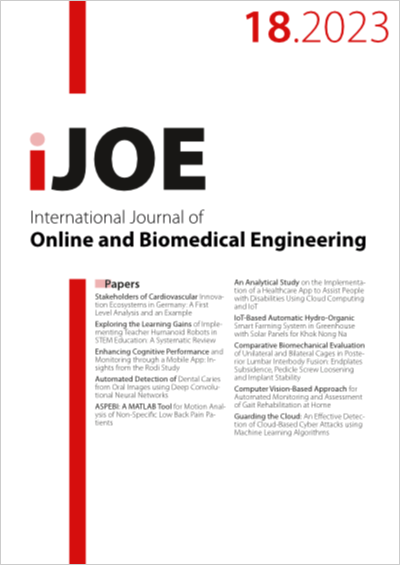Computer Vision-Based Approach for Automated Monitoring and Assessment of Gait Rehabilitation at Home
DOI:
https://doi.org/10.3991/ijoe.v19i18.43943Keywords:
Gait analysis, Pose estimation, Knee angle, Score rehabilitationAbstract
This study presents a markerless video-based human gait analysis system for automatic assessment of at-home rehabilitation. A marker-based MoCap system (Vicon) is used to evaluate the accuracy of the proposed approach. Additionally, a novel gait rehabilitation score based on the Dynamic Time Warping (DTW) algorithm is introduced, enabling quantification of rehabilitation progress. The accuracy of the proposed approach is assessed by comparing it to a marker-based MoCap system (Vicon), which is used to evaluate the proposed approach. This evaluation results in mean absolute errors (MAE) of 4.8° and 5.2° for the left knee, and 5.9° and 5.7° for the right knee, demonstrating an acceptable accuracy in knee angle measurements. The obtained scores effectively distinguish between normal and abnormal gait patterns. Subjects with normal gait exhibit scores around 97.5%, 98.8%, while those with abnormal gait display scores around 30%, 29%, respectively. Furthermore, a subject at an advanced stage of rehabilitation achieved a score of 65%. These scores provide valuable insights for patients, allowing them to assess their rehabilitation progress and distinguish between different levels of gait recovery. The proposed markerless approach demonstrates acceptable accuracy in measuring knee joint angles during a sagittal walk and provides a reliable rehabilitation score, making it a convenient and cost-effective alternative for automatic at-home rehabilitation monitoring.
Downloads
Published
How to Cite
Issue
Section
License
Copyright (c) 2023 safae talaa, Mohamed El Fezazi, Abdelilah Jilbab , Moulay Hachem El Yousfi Alaoui

This work is licensed under a Creative Commons Attribution 4.0 International License.



